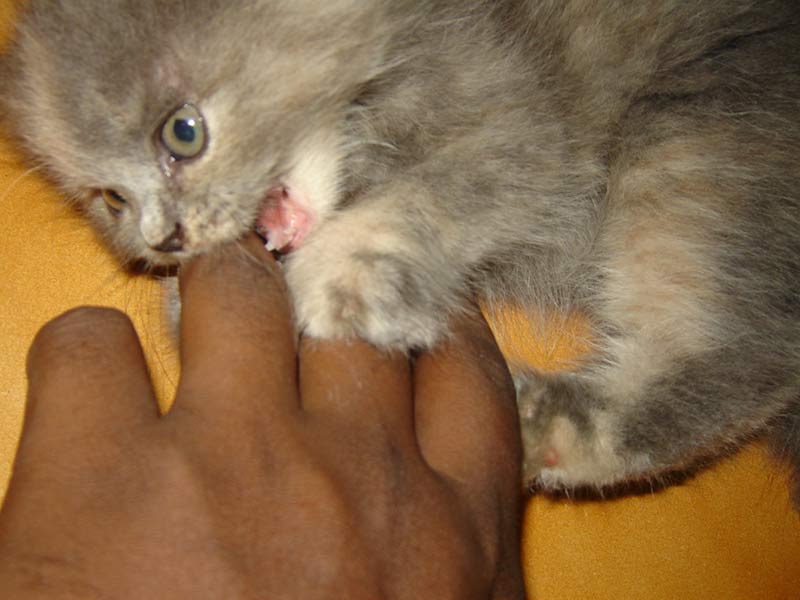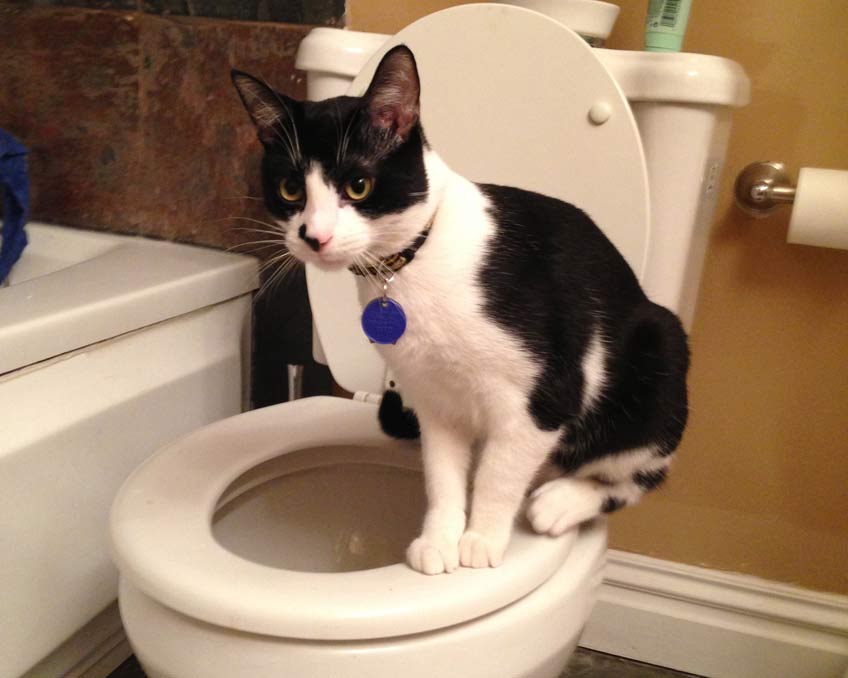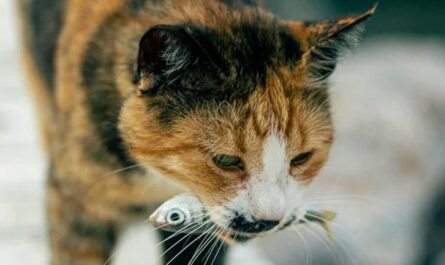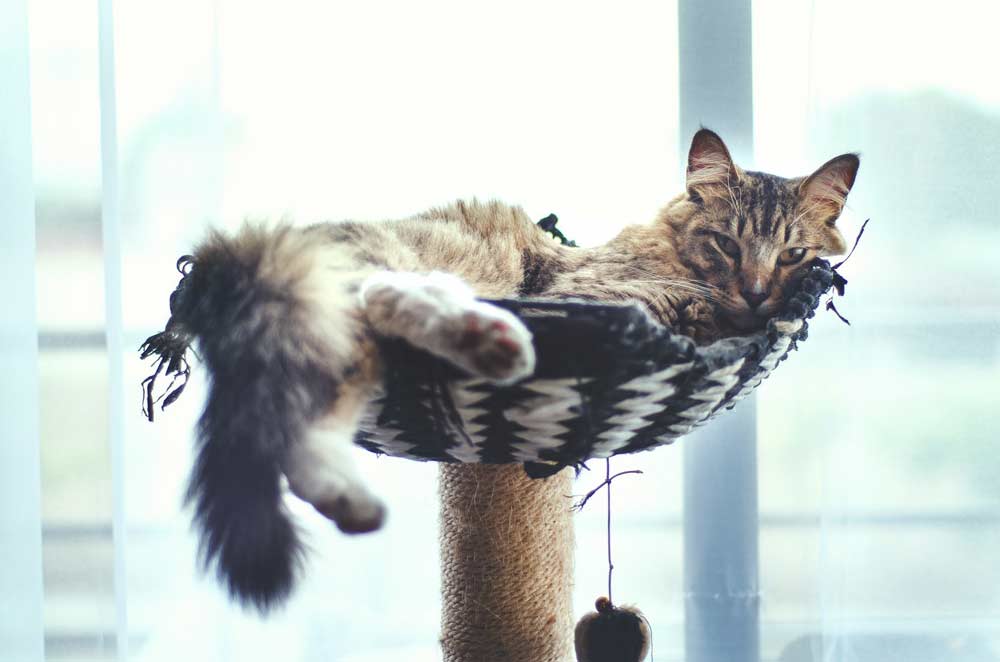How to train a cat not to bite? Cats and kittens naturally bite, pounce and claw, it is not always because of their aggressiveness, rather it’s their natural instinct. Cats are felines and by-born predators bite and scratch. It is the cat’s biological habit to explore their world by biting things. Therefore, biting does always not mean an aggressive and attacking attitude. Rather you will find playfulness and affection in many cases. In this article, I am going to discuss how to train a cat not to bite. Keep reading
Why do cats bite?
Biting comes naturally in the case of kittens as they explore their world by mouth, just like kids in many other species, including humans. However, this habit decreases significantly up to the age of one year. Yet, the change of attitude is very common in cats, and they often turn aggressive while petting, and start biting and clawing. As a pet owner, you must learn the body language of the cat well.
Cats bite when they feel frightened and mingled up with other kittens or cats. The past record of the cat is important in that case. Sometimes, biting is related to attention-grabbing or a way of communication. In the case of adoption, you need to check the history of the cats, which should have learned the etiquette and manner earlier. If not, it is your urgency to train them.
When do cats bite?
Cats bite in different situations subject to the change of mood and the situation they think is risky and scary. There are some particular types of cat biting, the most common types are aggressive biting and playful biting.
Cats undergo aggressive biting with force when it feels anger, afraid, or fury. The bite turns very aggressive and deep with bleeding and scratch. On the other hand, a playful bite doesn’t penetrate mush or cause much harm. Yet, the risk factors include a sudden change in the cat’s mood to transform the playful bite into an aggressive one. Whatever the situation it is not a good deal to allow cats to bite.
Even in an aggressive situation, you must take precautions to retard the cat from it. Avoid stimulators, triggers, or situations that might cause your cat to be aggressive. Situations like being rude to the cat, confronting any danger or other cats, or teasing the cat indiscriminately. Give your cat a reward and appreciation in every case it avoids its biting tendencies. Biting out of playing tendencies is common to the cat. The playful mood of the cat keeps its biting habits.
- GPS cat, dog, and Pet trackers
- Build Your Dog Box. 1 Box Every 3 MonthsBuild Your Cat Box. 1 Box Every 3 Months
- Litter Boxes for Your Lovely Kitten On Amazon
- Toilet Training Kit for Your Cute Cat On Amazon
- Cat Health Supplies on Amazon
- Cat Food Supplies on Amazon
- Cat Scratching Posts for Indoor Cats
The animal behavior counselor at Nirvana Trails in New York City, Mary Molloy says, “Playtime with littermates helps to teach a kitten bite inhibition, which means if you bite your sibling too hard, you’ll be avoided at best—or bitten right back at worst”.
1. The Trail of Overstimulation
Within the heartstrings of feline comportment, the siren song of overstimulation unfurls. Imagine a world where an alternate species persistently rouses you from your reverie, showering you with tactile affections. The panorama of feline life to encompasses this dynamic—the juncture where boundaries blur between intimacy and intrusion.
Herein lies a delicate equilibrium—a dance between adoration and the need for solitude. Much like a pendulum, some felines oscillate between the yearning for affection and the demand for respite. Certain breeds, akin to the cuddlesome Ragdoll, emerge as veritable connoisseurs of attention, weaving an intricate tapestry of feline-human interaction.
Peering into the corridors of memory, an epiphany crystallizes—cats harbor nuanced inclinations, telegraphing the unspoken plea for reprieve. As the crescendo of affection swells, a sense of overwhelm may loom—an undercurrent of sensory saturation that kindles the embers of discomfort.
Delve deeper, and hyperstimulation, a paradoxical plight, comes to the fore. Within the realms of this cognitive dissonance, excessiveness metamorphoses into a symphony of discomfort. Akin to an artistic crescendo that falters, hyperstimulation may pave the way for pain—an interplay where touch transcends pleasure to unfurl as an inadvertent source of distress.
2. Medical Factors
Amidst the enigmatic tapestry of feline behavior, the specter of medical afflictions casts a formidable shadow. Behind a seemingly innocuous bite, an undercurrent of pain and discomfort may course through the veins of our feline companions. Particularly poignant within the realm of aging cats, this phenomenon mirrors the human experience—a chronicle of bodily decline that conjures forth defensiveness.
The threshold of pain impels the feline heart to don the cloak of aggression. Older cats, akin to their canine counterparts, might lash out due to concealed discomfort. In this narrative, the mouth becomes a realm of vulnerability—the epicenter of pain that morphs into an instinctual defense mechanism. An arthritic adult cat’s bite may resonate with an undertone of agony, a plea to remain unencumbered by touch.
As the annals of existence unfold, cancer, a shadowy specter, may also cloak itself within the tapestry of behavior. Amidst the labyrinthine corridors of malignancy, erratic actions manifest—a testament to the profundity of the link between physical affliction and behavioral variance.
In this saga of interconnectedness, one dictum reigns—compassion and vigilance. Handle a discomforted feline with tenderness; allow them to gravitate toward solace. Extend your hand to the realm of veterinary care, ushering forth pain relief and the promise of enhanced quality of life. Amidst this complex ballet of pain and compassion, life finds its rhythm.
3. The Ballet of Playfulness
Akin to ethereal sprites, kittens epitomize the vivacity of youth—a carnival of energy that spirals through time’s embrace. Within the realm of playfulness, the choreography of biting unfolds—a manifestation of merriment that ensnares human companions in its jubilant web.
Consider a world where the playground knows no bounds—a realm where paws and laughter merge in a rhapsody of exuberance. A nip, a bite—mere preludes to the drama that ensues. In the realm of play, felines navigate the borderland between affection and frolic, their bites encapsulating the fervor of youthful abandon.
4. The Overture of Inquisitiveness
Enshrined within the feline psyche, the penchant for curiosity reigns supreme—a symphony of exploration that often traverses realms both familiar and obscure. Within this narrative of discovery, the act of biting may unfurl as a footnote—an emblem of curiosity that waltzes upon the stage.
Imagine the milieu of exploration—a feline gaze ensnared by the mysteries of the world, entranced by the tableau of the human domain. An outstretched hand, a manifestation of tactile allure, beckons forth the feline minstrel—only to evoke a swift bite, an enigmatic dance of curiosity and uncertainty.
Beneath this complex choreography lies the realization that felines are both observers and participants in the grand tapestry of life—a testament to the dance between instinct and interaction. Amidst this intricate dance, one perceives the call for recognition—the yearning for a space wherein feline inquisitiveness is acknowledged and nurtured.
5. Manifestations of Fear or Anxiety
Within the enigmatic tapestry of feline behavior, there exists a facet that occasionally unfurls in the form of biting—a response often birthed from the crucible of fear or anxiety. In the intricate choreography of feline emotions, instances of feeling threatened or engulfed by trepidation can act as triggers for this display. A feline, ensnared in a corner of vulnerability or thrust into the midst of the unfamiliar, might resort to biting as a last line of defense.
- Cat Water Fountain on Amazon
- Cat Carrier on Amazon
- Cat Automatic Feeders on Amazon
- Cat Guide Book on Amazon
- Cat Breed Book on Amazon
- Cat Behavior Book on Amazon
- Cat Training Book on Amazon
- Cat behavior Products on Amazon
- Cat Breed Test
Even the resonance of sudden, cacophonous sounds can serve as the catalyst for this eruption. Deciphering the language of your feline companion’s triggers is akin to unearthing hidden scrolls, granting you the power to steer clear of circumstances that kindle the ember of aggression. These bouts of turmoil might extend beyond bites, into the realm of scratching and fervent pawing at visages, a theatrical performance of distress.
6. The Veil of Pain or Discomfort
Pause and contemplate the realm where feline incisors become emissaries of anguish. When a cat resorts to biting, it might be an eloquent declaration of its struggle with pain or discomfort. A languishing dental malady or the silent throes of arthritis can propel a once tranquil feline into the tumultuous realm of aggression.
If the rhythmic cadence of their behavior undergoes a sudden transformation, if their propensity for biting intensifies, you are summoned to heed the clarion call of veterinary guidance. This juncture is rife with the dialect of vigilance, for not every nip from a feline’s maw is a herald of hostility.
7. The Tender Dichotomy of “Love Bites”
In the tender lexicon of feline expressions, a subtler variation of bites emerges—an enigmatic realm where bites fuse with affection, birthing what is known as “love bites.” These caresses, while adorned with the veneer of gentleness, bear a paradoxical hue—they convey endearment, yet they inflict a tender pain. These love-infused bites, tender in their intention, materialize as transient moments of contact between the teeth and the skin.
A cat, in its tender ardor, bestows these bites, unaware of the dual language it weaves—a tapestry where love and sensation intermingle. Yet, even as we peer into this delicate choreography, prudence calls us to guide these displays, lest they spiral into the labyrinthine depths of aggressive biting.
8. The Prelude to Transformation: Teething
Within the annals of feline existence, phases of transformation converge—an allegory of growth that echoes through the corridors of nature. Amongst these chapters, the act of biting may emerge as a harbinger of teething—a passage that traverses the chronicle of kittenhood.
As emerging teeth etch their presence upon the tapestry of kittenhood, a symphony of sensations unfolds. Bites may unfurl as an instinctual recourse—a bridge between discomfort and the discovery of relief. Through this lens, the act of biting transcends the realm of aggression, adorning itself with the vestments of necessity.
In the kaleidoscope of feline comportment, an enigmatic dance ensues—a dance where bites assume myriad hues, each stroke a stroke upon the canvas of feline-human communion. As the saga unfolds, one truth prevails—the feline heart, a repository of mysteries, beckons humanity to unravel the tapestry of its language, forging a symphony of empathy and understanding.
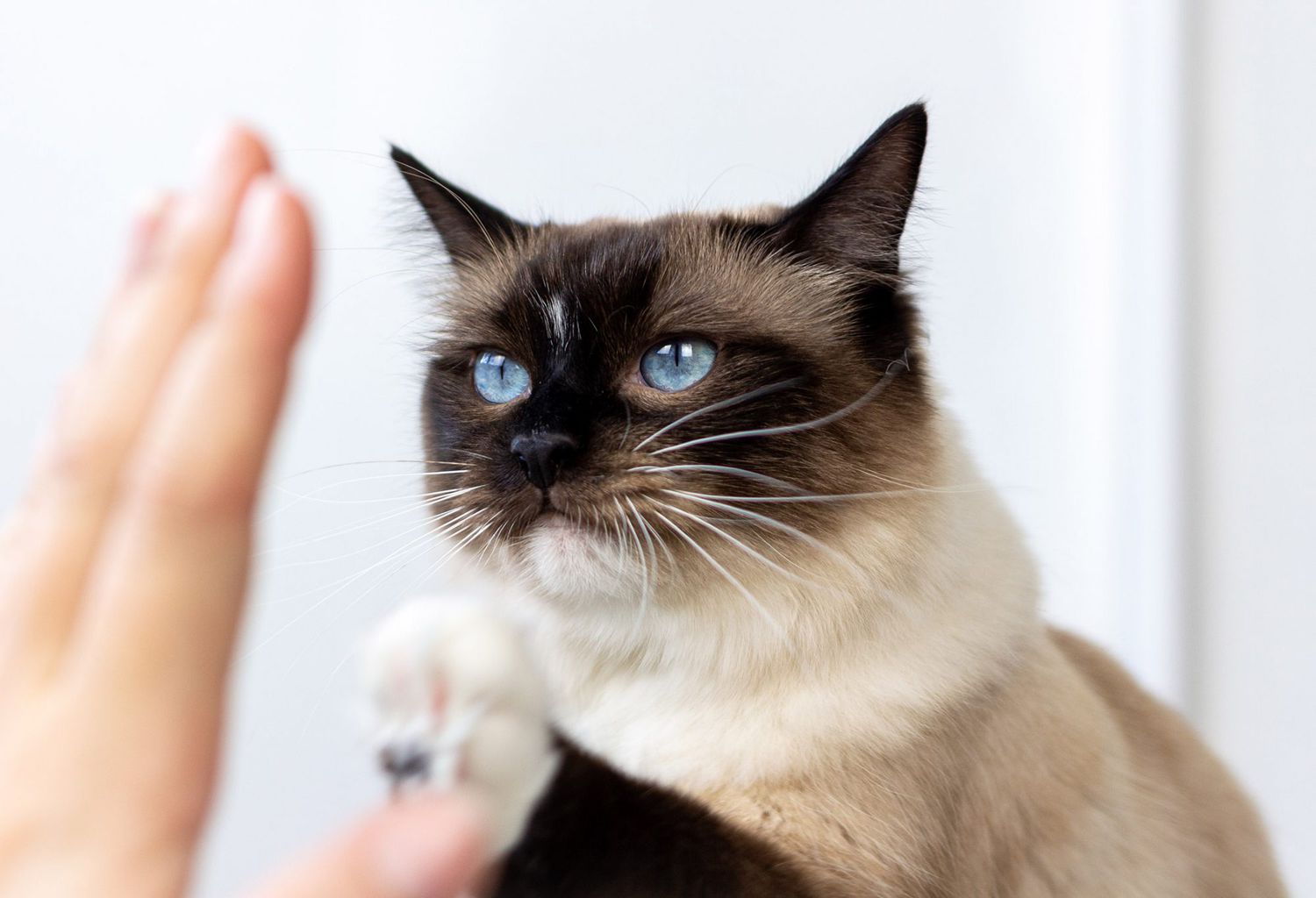
How Do I Know if My Kitten Is Teething?
Within the lifecycle of kittens, an epoch of teething unveils itself—a transitory phase akin to the teething trials of their canine counterparts. This theatrical dance of burgeoning teeth conveys an odyssey of discovery, a journey that traverses the realms of sensation. Glimpse into this temporal tapestry of transformation—a tapestry that mirrors the narrative of puppyhood, as emerging teeth etch themselves upon the canvas of growth.
Within this chronicle of dental emergence, the contours of teething stages become discernible. With each passing week, a chapter of transformation unfurls—a saga of teeth emerging, teeth falling, and the crescendo of feline maturation.
Amidst this unfolding chronicle, a melange of signs bespeaks the passage of teething. Observe the tableau—the absence of teeth, the tapestry of chewing, the ballet of sensitivity, the portrait of irritability, and the sonnet of appetite loss. In the theater of kittenhood, these manifestations compose a symphony—an ode to growth that resonates with the cadence of life’s myriad stages.
In the heartland of teething, an injunction resonates—cater to the evolving palate of your kitten, shielding them from undue discomfort. Within this nurturing cocoon, a quintessential truth endures—a feline’s journey, much like a constellation of celestial bodies, unfurls in a symphony of stages, each fragment a note in the grand score of existence.
When Does A Kitten Get Its Teeth?
- 0-2 weeks, no teeth
- 2-4 weeks, first teeth appear
- 5-8 weeks, baby teeth erupt until all 26 appear
- 11 weeks, baby teeth start to fall out
- 3-4 weeks, adult teeth start to appear in this order: incisors, canines, premolars, and molars
- 6-7 weeks, all 30 permanent teeth will be present
What to do when the cat bites?
Shout politely to make the cat clear that it’s painful. Slowly get your hand out of the cat’s mouth and redirect it with another sort of play. Make your cat clear that biting is not a play and you dislike it. Be consistent with your attitude and apply the same procedure in case the cat bites every time. Reward it for not biting. Give them new toys to play with. Using some code word like “AHH” or “OW” or “UHH” in every bite, your cat will get a signal that means he should stop it, or let it go.
- Buy Cat Accessories on Amazon
- The Complete Guide to Adopting a Cat: Preparing for, Selecting, Raising, Training, and Loving Your New Adopted Cat or Kitten
- Amazon Best Sellers: Best Cat Training
- Amazon Best Sellers: Best Pet Cats
- Amazon Best Sellers: Best Cat Care
- Amazon Best Sellers: Best Cat Care & Health
- Amazon Best Sellers: Best Cat Breeds
- Cat Products for Indoor Cats
- Cat Toys for Indoor Cats Best Sellers
- Surprise Subscription Boxes for Cool Cat On Amazon
You always have to be patient to deal with the cat’s biting. If you go with physical punishment or a harsh scold, the cat might be frightened.
What else to train the cat?
Be careful to give your cat such toys and types of play with the cat. Don’t use your body part as a jumping and catch toy for the cat. Bouncing and punching toys is better than playing with your hand. You can give the cat wand toys for biting and scratching, instead of your body part. Invent some safe and fun plays for the cat.
Always maintain zero tolerance in case the cat bints humans. Your discouragement will gradually discourage your dog from getting out of it. For not biting, you may offer treats and rewards. Every member of the family, friends as well as guests have to maintain this procedure in order to give the cat the same signal against biting. In case of different reactions from different people, you won’t be able to control the situation as the cat will be confused, about what to follow, and what to avoid.
Don’t encourage your cat with your empty hand or finger. Make it clear to the cat that hands or body parts are not a thing to play with. Make sure every member of your family maintains the same rule. Rather, provide the cat with many other toys to play with. Adequate toys will not make the cat bored. Keep them busy with toys, 2, 3, or 4.
Encouraging your cat to play with soft paws (claws withheld) or a soft mouth with you, family members, or other cats. Give the cat a reward for maintaining this habit. Gradually the cat will be able to be habituated. Help your cat to distinguish between your skin and clothes, by providing the cat with clots to bite.
Provide your cat with rewards and treats to make it learn to sit down when you enter the room. It will encourage your cat to adjust its behavior. Keep the training on a continuous basis to infuse learning in the cat. Have patience and be lenient with the pet, instead of being rude and aggressive. Rewarding is the best way for bringing training outcomes. I hope this article on how to train a cat not to bite was worthy to you.

How to Tell if a Cat Is Going to Bite
A voyage into the realm of interspecies understanding beckons, where communication transcends the boundaries of language. Biting, the arcane lingua franca of felines becomes a medium for expression—a lexicon woven into the very fabric of their existence. Herein lies a voyage to unearth the enigmatic cues preceding a feline bite.
1. Restlessness: The choreography of restlessness, when enacted in tandem with the preceding tail and ear theatrics, serves as a clarion call. An oscillation between quietude and unease echoes through your feline companion. The movement gathers momentum, an overture of transition. At such a juncture, discernment dictates your course—read the signals, and step away, allowing the tempestuous currents to subside.
2. Ears: The auditory antennae that crown a feline’s visage assume a pivotal role in deciphering its temperament. Ears poised forward in their natural disposition echo a state of attentiveness or tranquility. However, as the ears pivot backward, a harbinger of tempestuousness emerges. This augury, an unfurling of pointed ears, forecasts a looming onslaught—be it a playful gambol or a less amiable incursion. Vigilance, in such moments, becomes the watchword.
3. Tail: A feline sojourn in your lap might evince tranquility, yet a subtle orchestration unravels as the tail commences an enigmatic dance. The swishing tail, a serenade amidst stillness, punctuates a crescendo of anticipation. Beware, for a cat in repose, whose tail sways with newfound vigor, is poised to unravel its pent-up energies.
How to train a cat not to bite?
Yet, it’s risky in many cases for humans and kids to adjust to the biting tendency of felines. Cats and kittens are playful and affectionate with their biting and clawing, yet it will not be safe every time for the human. The bite and claw may be dangerous and infectious for you and your family, or even a guest who has just come home.
- Buy Bird Accessories on Amazon
- Buy Cat Accessories on Amazon
- Buy Dog Accessories on Amazon
- Buy Fish Accessories on Amazon
- Buy Pet Accessories on Amazon
The mantle of prevention rests upon the shoulders of every feline connoisseur. Cat bites, veritable reservoirs of bacterial infestation, carry a weighty mantle. Akin to alchemists, we forge a shield against biting, embarking upon a symphony of discouragement.
1. The Course of Affection: Affection, the elixir of camaraderie, is a sanctuary against tumultuousness. Drench your feline in love’s embrace, quelling their plaintive cries for attention. Dedicate moments to their comfort, and carve an oasis within their hearts.
2. Comrades of Play: Kindred spirits find solace in each other’s company. The realm of playmates beckons, a partnership forged in vivacity. A high-energy playmate might quell restless energies and sate voracious appetites, ushering harmony into your domain.
3. Decoding Cat Dynamics: Mastery over feline behavior unfolds as the cornerstone. When a swishing tail and ears relinquish their equilibrium, the imminent storm crystallizes. In these moments, eschew hand interventions, preferring a dignified exit instead.
4. Grasping Thresholds: Embrace your cat’s ephemeral tolerance, a window of interaction that dissipates with time. Fathom the symphony of their desires, gauging the crescendo before withdrawing. Partake in brief, meaningful interactions, attuned to the rhythm of your cat’s whims.
5. A Vow against Hands: Hands, bearers of sustenance and connection, are not conduits for admonishment. A tactile reprimand risks sowing seeds of agitation. Caution, too, against play without proper engagement tools—bare hands entice their aggression.
6. The Pantheon of Play: Toys, the emissaries of feline delight, infuse vibrancy into the daily tableau. A trove of playthings, embellished with scratching posts, satiates their desires. Combat boredom, for its offspring, is wayward behavior.
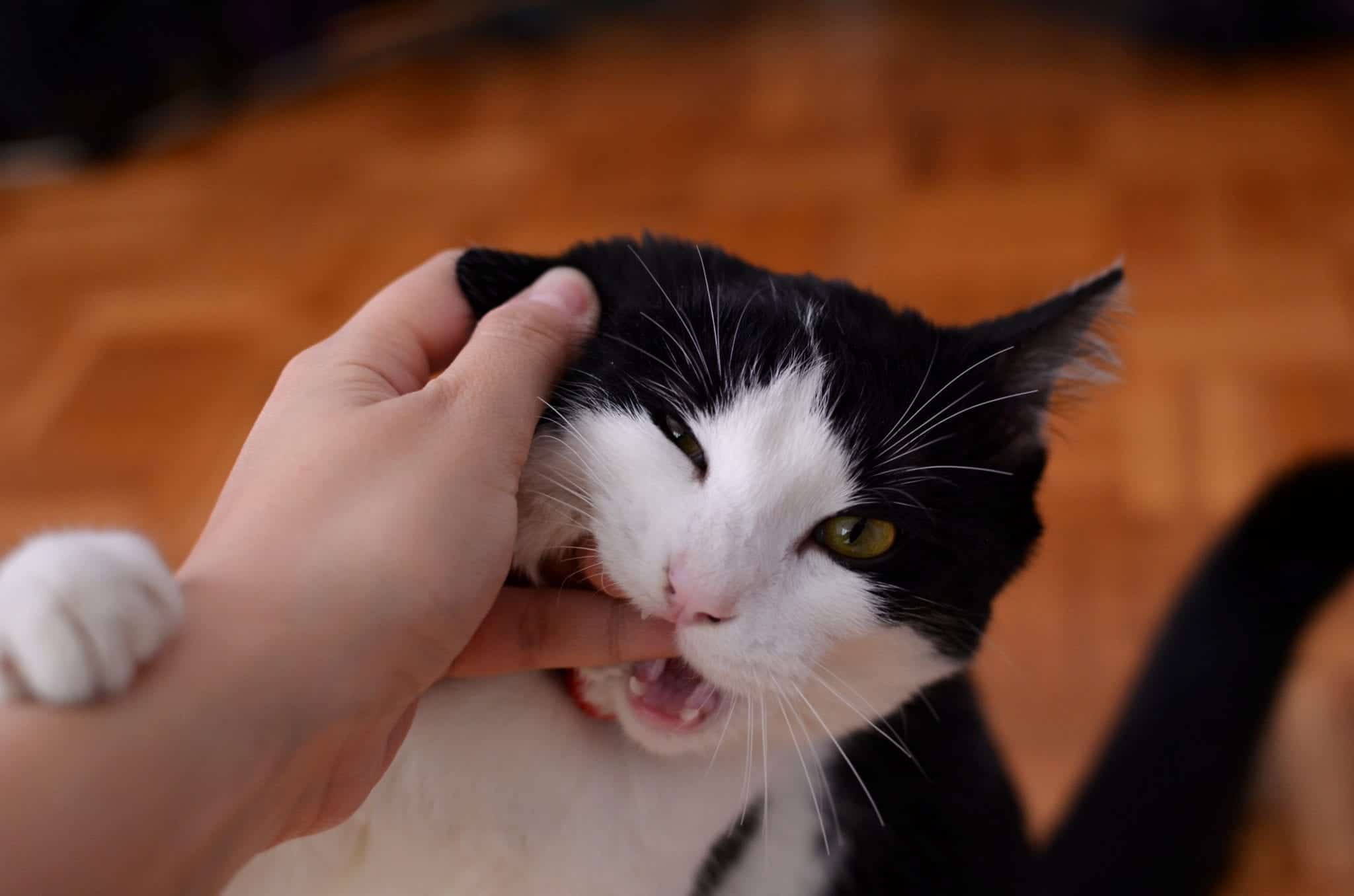
What to Do if You Get a Cat Bite
Amidst the tempest of a cat bite, the compass veers toward response. A symphony of caution unfurls a hymn of rectitude amid uncertainty.
1. Retreat from Aggression: A prudent retreat becomes the initial step, sparing escalation. Eschew aggression as a response, for heightened emotions birth discord.
2. Navigating Wounds: The aftermath demands meticulous care. Cascade your wound with water, anointing it with the balm of soap’s embrace. Traverse the path to medical aid—the sanctuary of a hospital or the counsel of a nurse, attuned to cat-inflicted wounds.
3. The Journey Ahead: The labyrinthine journey unfolds, paving the way for amicable coexistence. Seek solace in veterinary behaviorists, their expertise guiding you through the quagmire of behavioral complexities.
Urgent Actions to Take Following a Cat Bite
Cat bites, though compact, harbor the potential for discomfort and peril, given the feline’s precision-engineered weaponry—razor-sharp teeth that can effortlessly pierce the skin’s fortifications. If you find yourself ensnared by a cat’s bite, swift measures are imperative to thwart infection and expedite the healing process. In the chronicle of post-bite protocols, here are the immediate actions to undertake.
1. Engage in the Ritual of Cleansing
Commence the ritual by meticulously washing the wound with an elixir of soap and tepid water. This inaugural act assumes paramount significance, an ablution aimed at obliterating any vestiges of bacteria or soil that might have ensconced themselves on the skin’s tapestry. Invoke gentleness as you traverse the contours of the bitten terrain, ensuring meticulous exploration of every nook and cranny.
- GPS cat, dog, and Pet trackers
- Build Your Dog Box. 1 Box Every 3 MonthsBuild Your Cat Box. 1 Box Every 3 Months
- Litter Boxes for Your Lovely Kitten On Amazon
- Toilet Training Kit for Your Cute Cat On Amazon
- Cat Health Supplies on Amazon
- Cat Food Supplies on Amazon
- Cat Scratching Posts for Indoor Cats
However, shun the deployment of abrasive elixirs or antiseptics—like the volatile rubbing alcohol—as these agents bear the potential to further enkindle the wound’s ire. Post-purification, a gentle pat-down with a pristine towel or tissue affords the wound the dignity of dryness.
2. Unveiling the Elixir of Antibiotics
Embark upon the next chapter, wherein the elixir of over-the-counter antibiotic ointment graces the stage. This elixir, akin to a guardian of yore, unfurls its protective mantle to thwart the incursion of infection and engender the regal dance of healing. To partake in this ritual, adhere assiduously to the instructions gracing the ointment’s vessel. A clarion call resounds: should the wound unveil its depths or cascade a torrent of blood, an audience with the healers is requisite—an urgency fraught with the prospect of stitches, a rare yet conceivable reality.
3. The Enshrouding Embrace
Having anointed the wound with the balm of antibiotic ointment, proceed to shroud it beneath the benevolent embrace of a sterile bandage or dressing. This sanctified garb shall stand as a vanguard against the marauding forces of bacteria and grime, a citadel of protection that seeks to diminish the risk of infection. A ritual of rebirth shall transpire as the bandage is reinvoked and the antibiotic rekindled in rhythmic cycles, akin to daily incantations or whenever the veil succumbs to dampness or tarnishment. Vigilance becomes the watchword—ponder the wound’s visage, its tale woven with threads of increasing redness, swelling, or pus. And in the presence of these portents, heed the call of the medical sages without delay, for the lapse of time can breathe life into grievous complications.
In the chorus dance of post-bite edicts, these steps stand as sentinels, ushering you toward a sanctuary of healing.
/chew-chew-524443831-57d97b8f3df78c583398344b.jpg)
Preventing Cat Bites in the Future
The art of prevention holds the key to mitigating the risk of cat bites. By delving into the realm of feline behavior and orchestrating suitable precautions, you can erect a sanctuary of safety for both yourself and your feline confidant. Immerse yourself in these insights to steer clear of feline bites in the days ahead.
Avoid Rough Play
The siren call of boisterous play may beckon when your feline companion brims with vivacity and zeal. Yet, within this realm of play, the lines must be drawn—boundaries fortified to repel the seeds of biting behavior. Engaging in this rough-hewn dance might kindle embers of aggression and inadvertently sow seeds of harm. The prudent course lies in steering away from such tempestuous play and veering towards the corridors of interactive engagement, with toys that orchestrate a safe distance between your hands and the maw of your feline comrade.
Within this, not only do both parties find sanctuary but also the feline spirit locates a resplendent haven for its intrinsic instincts. Redirecting this vitality towards instruments that befit its nature engenders a synergy of companionship and engulfs their behavior in the gentle radiance of positivity.
Understand Your Cat’s Body Language
Behold the enigma of feline expression, encapsulated within the tapestry of body language. A symphony of ears, a ballet of tails, and the poetry of posture—these are the channels through which feline emotions cascade. When the ears of a cat stand poised, directed forward, and draped in relaxation, they unveil an essence of serenity and tranquility. Yet, the counterpoint emerges when these same ears lay flat against the cranial canvas—a somber canvas hinting at fear’s icy tendrils.
- Cat Water Fountain on Amazon
- Cat Carrier on Amazon
- Cat Automatic Feeders on Amazon
- Cat Guide Book on Amazon
- Cat Breed Book on Amazon
- Cat Behavior Book on Amazon
- Cat Training Book on Amazon
- Cat behavior Products on Amazon
- Cat Breed Test
The tale of a feline is spun in the eloquent movements of their tails. A tail poised in regal relaxation narrates a tale of openness, of approachability. Yet, when this same appendage billows like a nocturnal specter, it unfurls a chronicle of unease, a sonnet of restlessness. And then, the story extends beyond the appendages to the very curvature of the body—the sinews taut, the muscles yielding—an intricate narrative that sketches the contours of their emotional landscape. Such subtleties unearthed from the tapestry grant us glimpses into their inner world, a world where biting can become a tale told by triggers.
Facilitating Channels of Play and Activity
A feline’s existence is painted with the hues of play and movement, an ode to vitality and fulfillment. With offerings of toys, scratching posts, and orchestrated sessions of frolic, you bequeath them a realm of engagement and shield them from the clutches of ennui and frustration—elemental fuels for the flame of aggression and biting. Adorn their world with interactive puzzles that beget mental engagement and feather wands that become the brushes on the canvas of their minds.
Routine rendezvous with play, whether it be in the pursuit of a whimsical toy or in the symphony of interactive play with their human partner, douses the ember of exuberance and prevents the onset of the dullness that births frustration and aggression. Such endeavors, woven into the fabric of their days, emerge as the bulwark against unwarranted biting—a testament to the art of prevention and the language of fulfillment.
